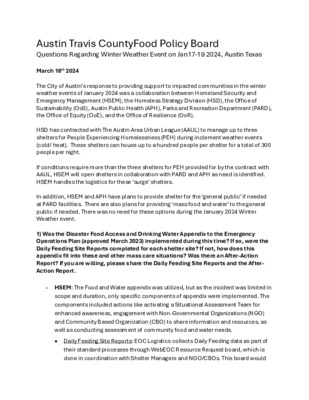Item 13. HSEM Response to Food Policy Board Questions - March 2024 — original pdf
Backup

Austin Travis CountyFood Policy Board Questions Regarding Winter Weather Event on Jan17-19 2024, Austin Texas March 18th 2024 The City of Austin’s response to providing support to impacted communities in the winter weather events of January 2024 was a collaboration between Homeland Security and Emergency Management (HSEM), the Homeless Strategy Division (HSD), the Office of Sustainability (OoS), Austin Public Health (APH), Parks and Recreation Department (PARD), the Office of Equity (OoE), and the Office of Resilience (OoR). HSD has contracted with The Austin Area Urban League (AAUL) to manage up to three shelters for People Experiencing Homelessness (PEH) during inclement weather events (cold/ heat). These shelters can house up to a hundred people per shelter for a total of 300 people per night. If conditions require more than the three shelters for PEH provided for by the contract with AAUL, HSEM will open shelters in collaboration with PARD and APH as need is identified. HSEM handles the logistics for these ‘surge’ shelters. In addition, HSEM and APH have plans to provide shelter for the ‘general public’ if needed at PARD facilities. There are also plans for providing ‘mass food and water’ to the general public if needed. There was no need for these options during the January 2024 Winter Weather event. 1) Was the Disaster Food Access and Drinking Water Appendix to the Emergency Operations Plan (approved March 2023) implemented during this time? If so, were the Daily Feeding Site Reports completed for each shelter site? If not, how does this appendix fit into these and other mass care situations? Was there an After-Action Report? If you are willing, please share the Daily Feeding Site Reports and the After- Action Report. - HSEM: The Food and Water appendix was utilized, but as the incident was limited in scope and duration, only specific components of appendix were implemented. The components included actions like activating a Situational Assessment Team for enhanced awareness, engagement with Non-Governmental Organizations (NGO) and Community Based Organization (CBO) to share information and resources, as well as conducting assessment of community food and water needs. • Daily Feeding Site Reports: EOC Logistics collects Daily Feeding data as part of their standard processes through WebEOC Resource Request board, which is done in coordination with Shelter Managers and NGO/CBOs. This board would connect Logistics with each site, and the sites could provide data regarding population numbers, food and water or dietary needs. • After Action Review: An AAR is planned but has not been conducted yet, however smaller-scale informal debriefs are being held for different functional areas to understand challenges and identify improvements. • Documentation: Daily Feeding data was managed through the Resource Request board in WebEOC, we can supply a summary report of Resource Requests for food & water that were submitted and filled. 2) How many meals were provided at the shelters and to how many people for this time? o Total bed nights = 2991 x 3 meals a day = 8,937 meals total AAUL = 3 shelters (300 people) COA ‘surge shelters’ = 2 to 4 shelters depending on the night 3) Who supplied the food and water to the shelters? Who managed the distribution of the food and water and what were the distribution models? Is there a list of who is contracted to provide food at shelters? o Surge food was coordinated by EOC Logistics and the Central Texas Foodbank (CTFB). When CTFB didn't have the capabilities, Jason's deli stepped in last minute. Water was provided out of HSEM warehouse inventory. - HSD - HSEM - HSD o Food for the 3 shelters managed by Austin Area Urban League was provided by Pam’s Kitchen (subcontracted with Domino’s pizza) 4) How was the food and water to the shelters funded? How much was spent on food and water resources for the shelters during this time, and is more funding needed for future disaster response? - HSEM: o Funded through HSEM funding codes o Water: 545 cases of water costing $3,662.40 o Food: CTFB - $11,639.00; Jason's Deli: $5,413.00 - HSD o Contract through HSD for AAUL 5) Was there daily coordination with community-based organizations (CBOs) that were also providing shelter and food/water access to unhoused individuals during this time? Was any funding or other support provided to those CBOs for this time? What role did the Resilience Hubs play during this weather response? - HSEM: o There was daily coordination with NGOs, CBOs, and other stakeholders at multiple levels. The EOC conducted daily coordination calls to bring involved stakeholders together to share operational information. American Red Cross (ARC), Austin Disaster Relief Network (ADRN), and the Central Texas Food Bank (CTFB) worked closely with the EOC and EOC logistics to share information and fulfill food and water needs in the shelters and/or in the community. A Liaison position was established in the EOC to connect with CBO's (ex. Community Resilience Trust) active in the incident by hosting and participating in coordination calls. CBOs were directly in contact with the Homeless Strategies Office (HSO), and the Emergency Operations Center (EOC) 3x daily. o The Office of Sustainability reached out to other CBOs to assess needs and identify any opportunities to engage and assist. o HSEM PIOs developed HSEM Newsletters that were distributed to CBOs and residents with helpful weather-related information and resources. o No specific financial assistance was given to CBOs or requested by them. The city did purchase food supplies for shelter meals from the Central Texas Food Bank (CTFB), as identified in answers 3 & 4. o Some Resilience Hub facilities were utilized to support Cold Weather Shelter operations for unhoused populations. This is due to these facilities being already established shelter sites, and that these facilities have been hardened against utility outages (e.g. better able to impacts from severe weather).